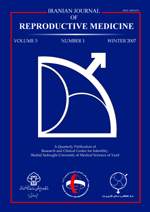
|
International Journal of Reproductive BioMedicine
Research and Clinical Center for Infertility, Shahid Sadoughi University of Medical Sciences of Yazd
ISSN: 1680-6433
EISSN: 1680-6433
Vol. 14, No. 6, 2016, pp. 383-388
|
 Bioline Code: rm16049
Bioline Code: rm16049
Full paper language: English
Document type: Research Article
Document available free of charge
|
|
|
International Journal of Reproductive BioMedicine, Vol. 14, No. 6, 2016, pp. 383-388
| en |
Expression level of chromodomain Y (CDY): potential marker for prediction of sperm recovery in non-obstructive azoospermia
Heydarian, Neda; Favaedi, Raha; Gilani, Mohammad Ali Sadighi & Shahhoseini, Maryam
Abstract
Background: The availability of testis specific genes will be of help in choosing the most promising biomarkers for the detection of testicular sperm retrieval in patients with non-obstructive azoospermia (NOA). Testis specific chromodomain protein Y 1 (CDY1) is a histone acetyltransferase which concentrates in the round spermatid nucleus, where histone hyperacetylation occurs and causes the replacement of histones by the sperm-specific DNA packaging proteins, TNPs and PRMs.
Objective: The aim was to evaluate CDY1 gene as a marker for predicting of successful sperm retrieval in NOA patients.
Materials and Methods: This research was conducted on 29 patients with NOA who had undergone testicular sperm extraction (TESE) procedure. NOA patients were subdivided into patients with successful sperm retrieval (NOA+, n=12) and patients with unsuccessful sperm retrieval (NOA-, n=17). Relative expression of CDY1 gene and chromatin incorporation of CDY1 protein were measured by quantitative real-time polymerase chain reaction (qRT-PCR) and ELISA assay, respectively.
Results: Quantification of mRNA relative expression and incorporation of CDY1 protein in chromatin showed significant lower expressions and protein levels of CDY1 in testis tissues of NOA- in comparison to NOA+ group.
Conclusion: The findings in this study demonstrated a correlation between the low levels of CDY1 function and unsuccessful sperm recovery in the testicular tissues of NOA- compared to NOA+ patients. Therefore, it can be reasonable to consider CDY1 as a potential biomarker for predicting the presence of spermatozoa, although the claim needs more samples to be confirmed.
Keywords
Azoospermia; CDY1; Gene expression; Marker
|
| |
© Copyright 2016 - Iranian Journal of Reproductive Medicine
Alternative site location: http://www.ijrm.ir
|
|
